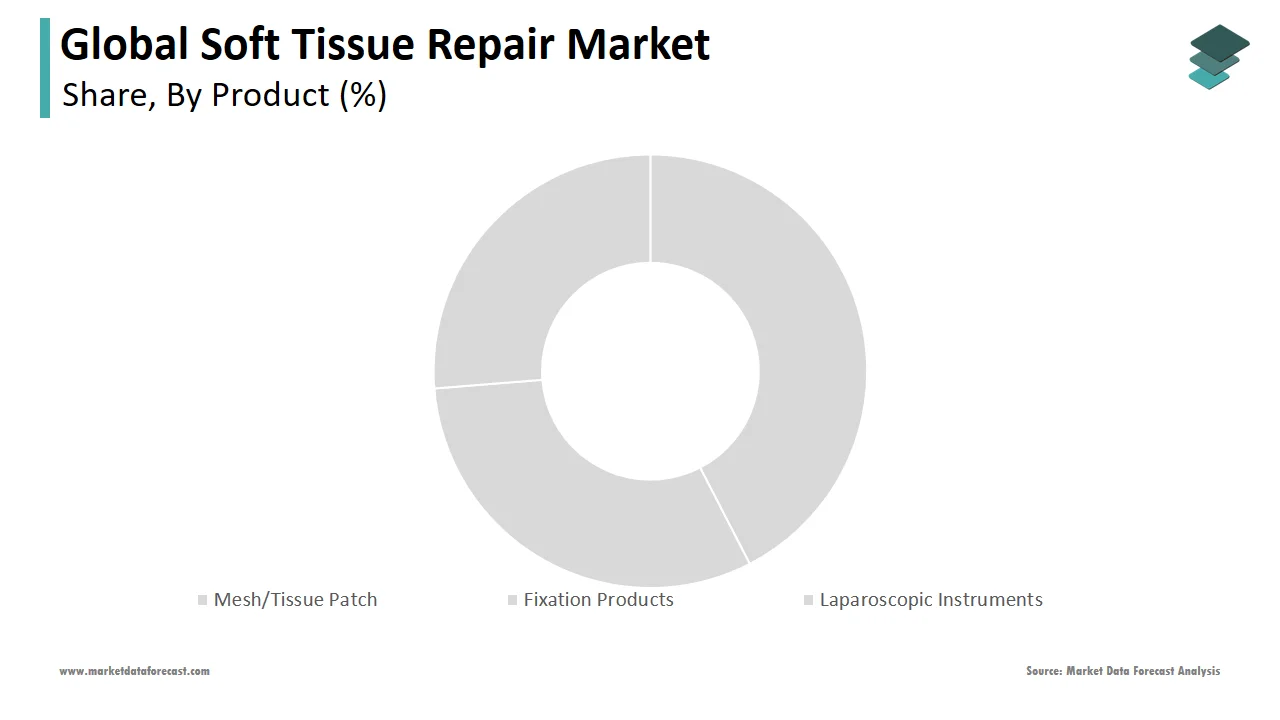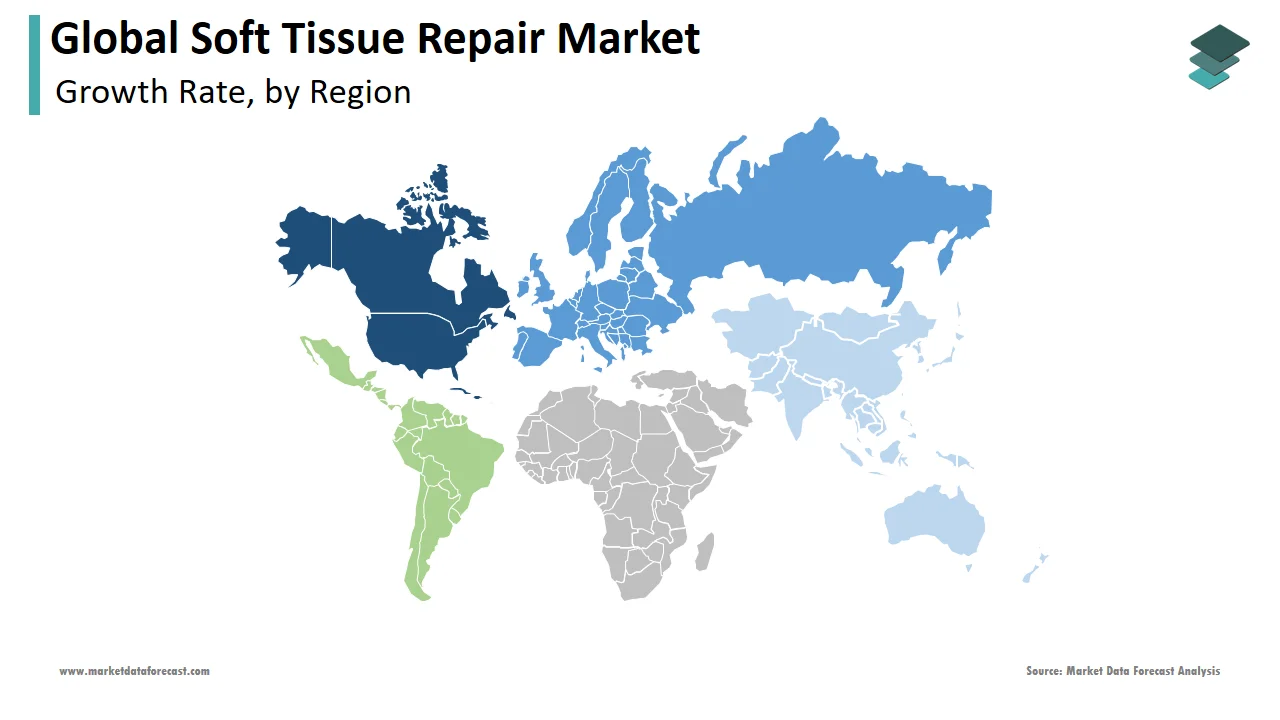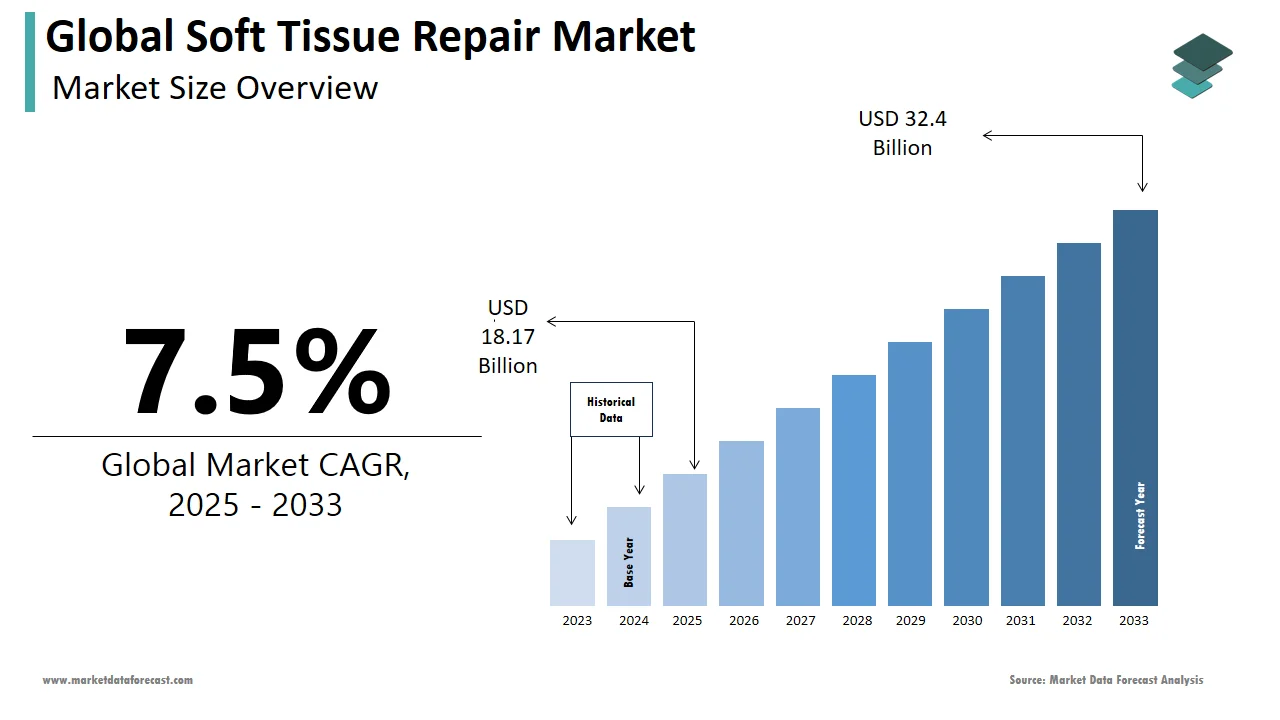Global Soft Tissue Repair Market Size, Share, Trends & Growth Forecast Report By Product (Mesh/Tissue Patch, Fixation Products and Laparoscopic Instruments), Application (Hernia Repair, Dural Repair, Vaginal Sling Procedures, Skin Repair, Orthopedic, Dental and Breast Reconstruction Repair) and Region (North America, Europe, Asia-Pacific, Latin America, Middle East and Africa), Industry Analysis From 2025 To 2033.
Global Soft Tissue Repair Market Size
The size of the global soft tissue repair market was worth USD 16.9 billion in 2024. The global market is anticipated to grow at a CAGR of 7.50% from 2025 to 2033 and be worth USD 32.4 billion by 2033 from USD 18.17 billion in 2025.
MARKET DRIVERS
The growing prevalence of sports activities and increased incidence of sprains and strains drive the growth of the soft tissue repair market.
The market growth is projected to drive by the growing need for soft tissue repair techniques in primary care settings. Soft tissue repair is frequently involved with significant consequences and, in unattended situations, might result in total failure. Soft tissue repair is prioritized in healthcare settings because of this. The introduction of biological grafts by significant manufacturers is gaining pace. Biological grafts offer a shorter recovery time and fewer problems related to rejection, which is expected to increase demand for these products. The soft tissue repair market is gradually shifting from traditional synthetic meshes to biological ones. Biocompatibility, strength, and aesthetics are all improved with these items. Growing awareness of the impact of these injuries on athletes' performance and awareness of available soft tissue repair therapy options is expected to drive the growth of the soft tissue repair market.
The growing number of patients suffering from sports-related injuries is boosting the soft tissue repair market growth.
Increased participation of children and adolescents in organized sports is projected to increase sports injuries. In addition, demand for goods is projected to rise as skilled physicians in soft tissue repair grow. Physicians are the actual medical equipment buyers, choosing the material, brand, and kind of tissue restoration operation. The rising number of physicians might expand the market for soft tissue repair products, resulting in overall growth. Traditional plastic meshes are being phased out in favor of biological meshes for soft tissue repair. Biocompatibility, strength, and aesthetics have all improved with these items. Obesity is on the rise, as are sports-related injuries, which is propelling the industry forward. Increased government and other organization funding are also assisting in the growth of this industry. New soft tissue healing procedures are being researched, as techniques involving synthetic and transplant materials have frequently failed. This is primarily due to a reduction in blood supply. The expansion of the soft tissue repair market is further aided by increased financing from the government and other organizations. A growing number of operations, fueled by an aging population and an increase in trauma cases, is expected to drive demand for the global soft tissue repair market, providing manufacturers with attractive growth opportunities.
MARKET RESTRAINTS
High costs and lack of favorable reimbursement policies hamper the soft tissue repair market growth. In addition, the lack of awareness among people regarding the advantages associated with soft tissue repair further inhibits the market’s growth rate. Furthermore, the lack of investments to conduct R&D in underdeveloped and developing countries further slows the market’s growth rate.
REPORT COVERAGE
|
REPORT METRIC |
DETAILS |
|
Market Size Available |
2024 to 2033 |
|
Base Year |
2024 |
|
Forecast Period |
2025 to 2033 |
|
Segments Covered |
By Product, Application, and Region |
|
Various Analyses Covered |
Global, Regional & Country Level Analysis, Segment-Level Analysis, DROC, PESTLE Analysis, Porter’s Five Forces Analysis, Competitive Landscape, Analyst Overview on Investment Opportunities |
|
Regions Covered |
North America, Europe, APAC, Latin America, Middle East & Africa |
|
Market Leaders Profiled |
LifeCell Corporation, Organogenesis, C.R. Bard Inc., Johnson & Johnson, Covidien plc, Arthrex Inc., Smith & Nephew plc, Integra Lifesciences Corporation, Wright Medical Technology, and Stryker Corporation. |
SEGMENTAL ANALYSIS
By Product Insights

Based on the product, the tissue/mesh segment occupied the highest market share in the global soft tissue repair market in 2024. The synthetic mesh dominated the segment within the sub-segments and estimated that dominance would continue. The biological mesh sub-segment is expected to showcase a healthy rate. This mesh is used to overcome the difficulties of synthetic meshes and offers mechanical support to the market. The Allograft sub-segment is observed to have lucrative growth as it is used in spinal fusion. It eliminates the need for extra surgical procedures and eliminates donor site problems such as infection.
The fixation products segment is estimated to exhibit a healthy CAGR during the forecast period due to the increasingly low cost of the products compared to tissue patches.
By Application Insights
Based on the Application, the orthopedic surgery segment accounted for the leading shares in 2024. Factors such as the growing number of trauma cases and sports-related injuries, growing obesity rate, and healthcare expenditure worldwide surge the segment’s growth.
The breast reconstruction repair segment was occupied second in accounting for the leading share in 2024, followed by the orthopedic segment. An increasing number of women who have breast cancer and the number of reconstruction surgeries are estimated to fuel the market growth of soft tissue repair products, promoting the market growth.
REGIONAL ANALYSIS

Geographically, The soft tissue repair market in North America will dominate due to an increase in the demand for treatment and a rise in patients' awareness about different treatment options. In addition, an increase in medical tourism in developing countries, rising investment of market players in the Asia Pacific region, especially in India and China, and increasing health awareness about soft tissue repair treatment will drive the Asia Pacific market in the forecast period.
The European soft tissue repair market is also anticipated to grow significantly during the forecast period. The increasing concern regarding health among people and technological advancement in products will increase the demand for soft tissue repair treatment to fuel the market's growth.
The soft tissue repair market in APAC is driven by factors like the rising prevalence of soft tissue injuries among the active aging population, increased involvement in sports, rising obesity rates, rising healthcare expenditures, and the absence of alternatives for soft tissue repair operations.
Furthermore, The soft tissue repair market in Latin America, especially in Brazil, will be driven by government support for treatment and a rise in healthcare expenditure. In addition, an increase in disposable income and changing lifestyles among populations in developing economies, increasing hernia repairs, growing incidence of breast cancer, and an increase in the treatment option for aging, especially for the senior population and minimally invasive procedures, drive the market growth of soft tissue repair, globally.
The soft tissue repair market in the Middle East and Africa is also projected to have an inclined growth graph in the future period. With the rise in awareness of diagnosis and treatment procedures, the market is moving forward enormously. In addition, the evolution of technology and the rising geriatric population are expected to drive the MEA market.
KEY MARKET PARTICIPANTS
A few noteworthy companies dominating the global soft tissue repair market profiled in this report are LifeCell Corporation, Organogenesis, C.R. Bard Inc., Johnson & Johnson, Covidien plc, Arthrex Inc., Smith & Nephew plc, Integra Lifesciences Corporation, Wright Medical Technology, and Stryker Corporation.
RECENT MARKET DEVELOPMENTS
- In July 2020, Wright Medical launched the first shoulder arthroplasty procedure using its Blueprint mixed reality technology. Mixed reality is the new addition to Wright's Blueprint ecosystem.
- In December 2020, Arthrex launched the first FDA-approved and cleared SwiveLock ACL Repair Kit. This is the first orthopedic company to develop and market the kit specifically for ACL repair.
- In February 2020, Integra Life Sciences Corporation announced AmnioExcel + Placental Allograft Membrane's latest wound care offering in supporting soft tissue repair. The company is developing new regenerative technologies to treat soft tissue wounds and help patients recover quickly.
- In September 2020, Smith + Nephew launched the CE mark-approved Novostitch Pro meniscal repair system. The system is used to repair meniscal tears and closes the gap present in the meniscectomy. In addition, Novostitch enables surgeons to place stitches arthroscopically.
- In July 2016, Stryker invented SonicAnchor, a soft tissue fixation system used to repair surgeries that reattach tendons to bone. The implantation uses ultrasonic energy for more stability to hold.
MARKET SEGMENTATION
This market research report on the global soft tissue repair market has been segmented and sub-segmented into the following categories.
By Product
- Mesh/Tissue Patch
- Synthetic Mesh
- Biological Mesh
- Allograft
- Xenograft
- Fixation Products
- Suture Anchors
- Interference Screws
- Other Fixation Devices
- Laparoscopic Instruments
By Application
- Hernia Repair
- Dural Repair
- Vaginal Sling Procedures
- Skin Repair
- Orthopedic
- Dental
- Breast Reconstruction Repair
By Region
- North America
- Europe
- Asia Pacific
- Latin America
- The Middle East and Africa
Frequently Asked Questions
What factors are driving the growth of the soft tissue repair market?
The rising prevalence of soft tissue injuries and disorders, a growing geriatric population, advancements in regenerative medicine, and rising healthcare expenditures are majorly driving the growth of the soft tissue repair market.
What region are expected to experience the fastest growth in the global soft tissue repair market?
In the coming years, the APAC region is expected to register the highest CAGR in the worldwide market.
What are the major challenges facing the soft tissue repair market?
High costs associated with soft tissue repair procedures, regulatory hurdles for new product approvals, and the availability of alternative treatment options are some of the notable challenges to the soft tissue repair market growth.
Related Reports
Access the study in MULTIPLE FORMATS
Purchase options starting from $ 2500
Didn’t find what you’re looking for?
TALK TO OUR ANALYST TEAM
Need something within your budget?
NO WORRIES! WE GOT YOU COVERED!
Call us on: +1 888 702 9696 (U.S Toll Free)
Write to us: [email protected]

